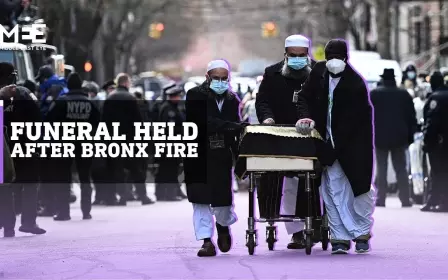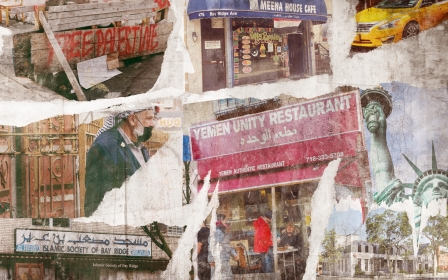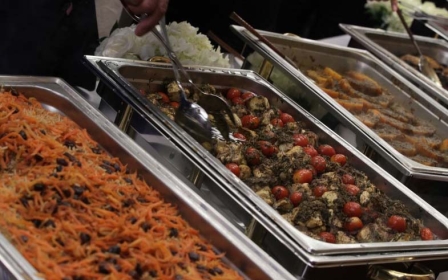US: How an abandoned New York church turned into a Muslim community centre
In one of the whitest neighbourhoods in New York City, there stands a former church that had been abandoned for nearly a decade. The house of worship had become an animal habitat with raccoons jumping out of the rafters, birds soaring in and out of the facility and rats napping on the pews.
What was once the beautiful St John’s Episcopal Church had turned into an eyesore, and it stayed like that for eight years while it was on the market. Before it went up for sale, the church had been steadily losing members. Yet while the Brooklyn neighbourhood of Bay Ridge was experiencing a shrinking Christian community, its Arab and Muslim numbers were mushrooming.
So in 2020, a group of Muslims got together, raised $2.6m and bought the church. The local community board gave the group a 98 percent approval rating and the community welcomed them. Three years later, while the outside facade remains the same, the inside has transformed.
Walk into what was once a church and take a left, and you are met with rows of prayer mats facing the direction of Mecca. A pulpit is situated in the front of the room, where a young man was reciting the Quran to the imam.
Take a right and walk up the stairs, and you are met with books about Islam. Walk some more and you are met with boxes upon boxes of food for the weekly food pantries and young people, as many of them volunteer for the countless programmes that take place inside the building.
New MEE newsletter: Jerusalem Dispatch
Sign up to get the latest insights and analysis on Israel-Palestine, alongside Turkey Unpacked and other MEE newsletters
It has become a community centre of sorts with a far-reaching vision for the future generations of Brooklyn's Muslims.
Bibi Esahack is the executive director of the Bay Ridge Community Development Center (BRCDC), a non-profit founded in 2016. During the height of the pandemic, BRCDC, under the leadership of the Islamic Society of Bay Ridge, raised $2.6m to purchase the church. But how did they convince community members to give that much money?
“We didn't have to convince anyone. People called us and said they wanted to donate,” she said.
Esahack recalled a story of a group of elderly women who brought their piggy banks and said they had been saving money for the last 15 years and wanted to donate it. One man brought a cheque for $15,000.
He told them, “You may not remember me, but when I came to the US, I didn’t know what to do or where to go. I couldn’t speak English. The only place I knew was the Islamic Society of Bay Ridge. I went in there and I was greeted with open arms. I was given a place to sleep. They helped me find a job. They gave me food. And now all these years later, I am in a position to donate $15,000.”
For a community that had always been generous, the generosity was being repaid. Esahack believes it’s because people see the need to save the next generation of Muslims in America.
“They don't want to see their kids on the street. They don't want to see guns in their hands. They don't want to see drugs. They want to know that there's a space for our kids to go to. And there's also a space for them,” she said.
A place for everyone
The most important aspect of the centre is that it’s not just a place for youth, it’s more of a community facility. This is why Esahack is creating intergenerational programming for a “centre that is constantly moving and inviting to every single person".
It’s also not just a mosque where the call to prayer, the adhan, blasts out of speakers five times a day. It’s a community centre with a mosque inside of it - and that’s a big difference, Esahack noted. In New York City, there are mosques constantly popping up within a small radius. But many of these mosques are often empty, except during prayer times, and she felt that needed to change.
A 2016 Institute of Social Policy and Understanding (ISPU) report showed approximately 768,767 Muslims live in New York City, making up about 8.96 percent of the city's total population of 8,583,000. In contrast, Muslims only make up one percent of the total US population.
Esahack believes that with a growing number of Muslims in New York City, there’s a growing need for community spaces. The youth are no longer satisfied with attending the Young Men's Christian Association (YMCA) or the Jewish Community Center (JCC), she said.
“They want their own centres. They want to be able to write their own history. They want to be able to be part of the narrative, and not just piggyback on anybody else. And I think that as community members, we have to fill that need for them,” she said.
“I'm 100 percent sure they are going to take it to a level that I didn't even dream of, but at least it will give them the foundation to get there.”
Mohamed Zin is a volunteer at BRCDC. He spends his time with young people and takes part in the weekly food pantries. For him, this is a much-needed community centre.
"The centre provides something for every member of the community regardless of their age and faith. We cater to Muslims but anyone and everyone is welcome," he told MEE. "We have always needed something like this in our community. And in a few years, once it's completely renovated, that is when more people will see that."
Immediately after the property was purchased, they retrofitted the space and began programming. The first programme was the food pantry. It began in the midst of the pandemic and exists even today with lines continuing a few blocks every week.
Esahack has been working hard to completely renovate the entirety of the space. To do that, she hired a non-Muslim architect who has worked with churches and community centres before.
“Something that was really important to me was to say, ‘How do we keep the integrity of such a beautiful building?’” she said. “This is a historic church. It has been here for over 100 years. And I don’t want to destroy that history.”
“I often think about the Hagia Sophia in Turkey. When the Muslims conquered Istanbul, they didn’t destroy the church. So when we bought this church, I knew they’d been doing good work for a century. And the idea was to complete that legacy and continue the work.”
Converting churches into mosques
Though there aren't concrete numbers showing how many churches have been converted into mosques, there have been many both in New York and the US as a whole. Masjid 'Eesa ibn Maryam is a mosque that was once a church in Queens, New York. In Buffalo, a Roman Catholic church was turned into a mosque and another was turned into a Buddhist temple.
US cities with shrinking populations have faced tremendous challenges in conserving their heritage, according to a study named, "Serendipitous conservation: faith-to-faith conversion of historic churches in Buffalo", in the Journal of Urbanism.
"Places of worship like churches, however, are difficult to rehabilitate, and cities lose this urban heritage after years of vacancy and neglect, and eventual demolition," the study stated.
"In many shrinking cities, particularly those now welcoming new immigrants and refugees, serendipitous conservation of vacant churches through faith-to-faith conversion can be an asset to local planners and preservationists in their fight to save urban heritage from demolition."
In some cases, a congregation or a religious governing body would sell the church to developers who would then turn it into apartments, offices, or performative spaces. But for churches in areas that are less attractive to developers, other religious groups, such as Muslims, would buy them and convert them into their houses of worship.
The inside of the new Muslim community centre in Bay Ridge still has stained glass windows and much of the architecture from the church remains. There are still crosses etched into the walls and crosses dangling from the lighting. There’s a giant cross on a pole on the front lawn, but soon it will be taken down to make space for crescent moons and stars.
According to Esahack, one of the most important aspects of the centre is that it doesn't discriminate. At the same time, it also doesn’t compromise its Islamic principles. She says more often than not, non-Muslims will come into the centre and notice that when it’s time for prayer, Muslims will leave whatever they were working on to go and pray. And seeing that has left an imprint.
“The idea is to build a model. If this model is successful, it could be used anywhere in this country. And so when I think about a community centre, I think about my own kids,” she said.
“I don't want my kids or any Muslim kids to inherit a broken system, a broken masjid or a broken community centre. They should inherit a space that is going to be flourishing, and they are just naturally coming in and taking over after one generation passes away.”
Middle East Eye delivers independent and unrivalled coverage and analysis of the Middle East, North Africa and beyond. To learn more about republishing this content and the associated fees, please fill out this form. More about MEE can be found here.





